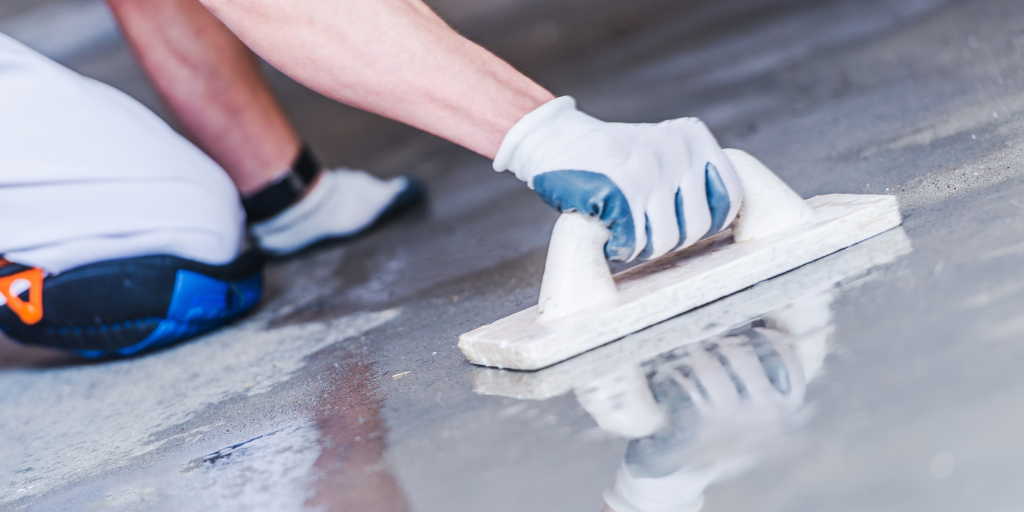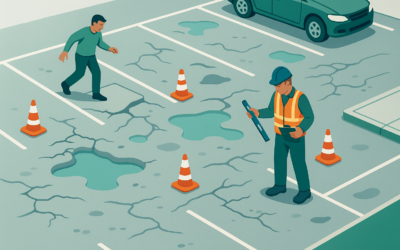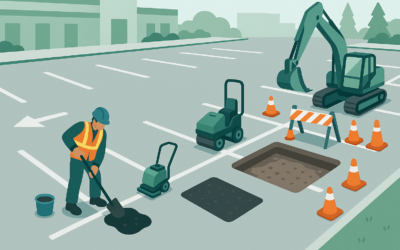Concrete Repair
Concrete is a popular construction option for building a home and for general uses around your property in places such as building driveways, sidewalks, and patios. It’s a great option because it’s generally long-lasting and has a smooth surface finish. Over time though, concrete will start to crack. It’s important to keep all the concrete in your home in good shape to avoid damage and expensive repairs.
Table of Contents
Here are some common reasons why concrete gets damaged and cracks over time:
Drying Shrinkage Cracks
As concrete dries, it shrinks. This can cause cracking, especially in hot weather or if the concrete is not properly cured. Drying shrinkage cracks are usually fine and hairline in nature. They can be prevented by keeping the concrete moist during the curing process, which can be done by covering it with plastic or spraying it with water.
Thermal Contraction Cracks
Concrete can crack when it is exposed to extreme temperatures, either hot or cold. Thermal contraction cracks are usually wider at the surface and taper down as they get deeper. They can be prevented by using expansion joints in the concrete.
Chemical Reactions Cracks
Concrete can also crack as a result of chemical reactions, such as those that occur when salt is used to de-ice a driveway. These cracks are typically wider at the surface and taper down as they get deeper. They can be prevented by using a sealer on the concrete.
Loading Cracks
Cracks can also occur from loading, such as when a heavy vehicle is parked on concrete that is not thick enough. These cracks are usually wider at the bottom and taper up as they get shallower. They can be prevented by using thicker concrete.
How to Repair Cracks in Concrete
No matter how well you take care of your concrete, there will come a time when it needs to be repaired. Cracks can form for a variety of reasons, but they can all be fixed if you know what to do. Here are the steps you need to take to repair cracks in concrete.
Step 1: Clean the Crack
The first step is to clean the crack. This will remove any dirt, debris, or vegetation that might be in the way. Depending on the size, you may use different methods to clean the crack.
- If the crack is less than 6mm wide, you can use a wire brush, putty knife, or vacuum cleaner to clean it.
- If the crack is wider than 6mm but less than 13mm wide, you can use a chisel and hammer to clean it.
- If the crack is wider than 13mm, you will need to use a power washer or hose to clean it.
Step 2: Fill the Crack
Once the crack is clean, you need to fill it with a patching compound/cement filler. This can be done with a variety of materials, such as Portland cement, epoxy, or polyurethane. The type of filler you use will depend on the size and depth of the crack.
- Epoxy filler is a type of concrete filler that is made up of two parts: the resin and the hardener. It is usually used to fill larger cracks in concrete. The resin and hardener are mixed together and then poured into the crack. Once it dries, it forms a hard, waterproof seal. Epoxy filler is a good choice for cracks that are less than 6mm wide.
- Polyurethane filler is another type of concrete filler. It is made up of two parts: the resin and the hardener. Like epoxy, it is mixed together and then poured into the crack. Once it dries, it forms a flexible, waterproof seal. Polyurethane filler is a good choice for cracks up to 13mm wide.
- Mortar filler is a type of concrete filler that is made up of three parts: sand, cement, and water. It is usually used to fill smaller cracks in concrete. The sand, cement, and water are mixed together and then poured into the crack. Once it dries, it forms a hard, waterproof seal.
Once you have chosen your filler, you need to mix it according to the manufacturer’s instructions. Once it is mixed, pour it into the crack and use a tool to spread it evenly.
Step 3: Seal the Crack
After the filler has dried, you need to seal the crack to protect it from further damage. After the repair has been made, it is important to allow the repair to cure for 24 hours.
You can use a variety of sealants, such as acrylic or silicone.
- Acrylic sealant is a type of sealant that is made up of acrylic resin and water. It is a good choice for sealing cracks in concrete because it is flexible and waterproof. It dries quickly and forms a hard, durable seal.
- Silicone sealant is a type of sealant that is made up of latex resin and water. It is a good choice for sealing cracks in concrete because it is flexible and waterproof. It works well in outdoor areas because it is UV resistant and can withstand extreme temperatures.
Concrete crack repair color match
If you are using epoxy to repair a concrete crack, you may want to color match the epoxy to the concrete. This can be done by adding a pigment to the epoxy before applying it to the crack. Alternatively, you can buy pre-colored epoxy. It’s important to match the color of the epoxy to the concrete so that the filler will be less noticeable. Once the epoxy has cured, it can be sanded and painted to match the surrounding concrete in case the color needs fine-tuning.
Concrete Driveway Repair
Concrete driveways are a popular choice for homeowners, as they are durable and easy to maintain. However, it is important to take steps to protect your driveway from cracks and other damage.
Here are some common reasons why concrete driveways get damaged and crack over time:
Settlement
One of the most common causes of cracks in concrete driveways is settlement. As the ground beneath the driveway shifts and settles, the driveway can crack and buckle. This is especially likely to occur in areas with high clay content in the soil. Tree roots can also cause settlement, as they grow and expand underground.
Drainage
Another common cause of cracks in concrete driveways is poor drainage. If water is allowed to pool on the surface of the driveway, it can seep into the concrete and cause cracks. This is why it’s important to make sure that your driveway has adequate drainage. Gutters and downspouts can help direct water away from the driveway, and a French drain can also be installed to collect and redirect water.
Weather
Extreme weather conditions can also cause cracks in concrete driveways. In the winter, freezing temperatures can cause the water in the concrete to expand, leading to cracks. In the summer, the intense heat can cause the concrete to dry out too quickly, causing it to shrink and crack.
If you are experiencing a concrete driveway crack, it is important to take action as soon as possible to prevent the problem from worsening.
Repair Options for Concrete Driveways
There are a few different ways to repair cracks in concrete driveways. The best method will depend on the size and severity of the damage or crack.
Resurface
If narrow cosmetic cracks are the problem, you can restore the appearance of your driveway with a resurfacing product. These cosmetic cracks are up to 25mm wide. Resurfacing is a less expensive option than replacing the driveway, and it can help prevent further damage. The resurfacing product is a cement-based coating that is applied to the surface of the driveway. It can be textured or smooth, and it can be tinted to match the color of your concrete.
Replace
If your concrete driveway is severely damaged and needs to be replaced, it is important to choose the right contractor. A qualified contractor will be able to assess the damage and recommend the best course of action. In most cases, it is cheaper to repair a driveway than to replace it, so it is important to know the difference between the two procedures.
Repair
If your concrete driveway has crumbling edges, it means that the concrete is breaking down and falling apart. In order to repair this, you will need to remove the damaged concrete and replace it with fresh concrete. Repairing a concrete driveway is a more extensive process than patching but less expensive than replacing the entire driveway.
Patch
Concrete patching is a quick and easy repair that will make your driveway look like new again. It is used to fill wider cracks that are less than 13mm wide. The patching compound is a cement-based filler that comes in a variety of colors. It is applied to the surface of the crack, and then it’s smoothed out. Once it dries, it will be indistinguishable from the rest of your driveway. Patching is a less extensive process that involves filling in the cracks with epoxy or another material.
Concrete
For cracks that are more than 13mm wide, you may also need to use concrete to fill the crack. First, clean out the crack with a wire brush or drill bit. Then, mix the concrete and pour it into the crack. Use a trowel to smooth it out, and be sure to allow the concrete to cure for the recommended amount of time before using your driveway again.
Cost DIY vs Contractor
If you’re considering repairing your concrete driveway cracks on your own, it’s important to weigh the pros and cons of DIY vs hiring a contractor. Repairing concrete driveway cracks on your own can be less expensive than hiring a contractor. However, contractors are more likely to have the experience and equipment necessary to do the job correctly. This can save you time and money in the long run.
The cost of repairing a concrete driveway will vary depending on the size and severity of the crack. In most cases, it will be less expensive than replacing the driveway entirely. Repairing a 6m, 25mm wide crack in your concrete driveway will cost you approximately $100. If you hire a contractor to do the job, it will cost you closer to $300. However, a contractor will be able to do the job in a fraction of the time it would take you to do it yourself, and they will have the necessary equipment. They will also have the experience to make sure the repair lasts.
If you have cracks in your concrete driveway, it’s important to have them repaired as soon as possible. In most cases, it is less expensive to repair a driveway than to replace it. A qualified contractor can assess the damage and recommend the best course of action to have your driveway looking at its best in no time.
Other types of concrete cracks you might have in your home
Concrete floor repair
A concrete floor is a sturdy and durable surface that is perfect for homes and businesses. It can be used in any room, and it is easy to clean and maintain.
There are a few different types of concrete repairs that can be used for a concrete floor. Patching compound is a quick and easy repair that would most likely be the best fit for a concrete floor crack up to 13mm wide. The concrete repair must be applied to the crack and smoothed out with a putty knife, and it will need to cure for a period of time before it is fully effective.
Concrete countertop repair
A concrete countertop is a strong and long-lasting surface that’s easy to maintain. Concrete countertops are available in a variety of colors and styles, so you can find the perfect one for your home or business.
If your countertop is cracked, it will most likely be a small crack that’s less than 13mm wide. These cracks can be repaired with a patching compound. If the crack is wider, the countertop may need to be replaced.
Concrete Step Repair
Concrete steps are strong, can be used in any weather, and are easy to clean. When concrete steps become cracked or damaged, they can be repaired with a concrete patching compound.
Concrete steps can also be susceptible to breaking down or crumbling around the edges. This requires a more involved repair process. The first step is to remove any loose concrete from the area. Then, you will need to chisel out the damaged area so that it is level with the rest of the step. Once the area is prepped, you can mix concrete and pour it into the void. Use a trowel to smooth it out and then allow it to cure for 24 hours before using the steps.
Concrete Foundation Repair
If you have a crack in your concrete foundation, it will most likely be a vertical crack that’s less than 6mm wide. These cracks can be repaired with a concrete patching compound. If the crack is wider, you will need to use concrete to fill the crack.
It’s important to repair cracks in your concrete foundation as soon as possible. Cracks in your foundation can let water seep into your home, which can lead to mold and mildew. If the cracks are left unrepaired, they will only get worse over time.
Concrete Slab Repair
If you have a broken concrete slab, the first thing you need to do is identify the source of the break. Once you have identified the source, you can repair it with a patching compound. Be sure to use a compound that is designed for concrete slabs.
Once you have identified the source of the break and repaired it, you might need to level the concrete slab. First, use a jackhammer to remove any broken pieces of concrete. Next, use a shovel to remove any loose dirt or debris. Finally, use a trowel to level the surface of the concrete slab.
It’s important to fix concrete cracks as soon as you notice them. Small cracks can quickly turn into big problems, and the sooner you fix them, the less expensive the repair will be. There are a variety of concrete repairs that can be used to fix cracks, and the best one for your needs will depend on the size and severity of the crack. Be sure to choose a repair that is designed for concrete and follow the instructions carefully to ensure the best results, or, find a quality concrete repair handyman near you.
Concrete repairs are a necessary part of home ownership. By knowing the different types of repairs, you can save yourself time and money. With a little bit of knowledge, you’ll know the best course of action to take when you see damage or crack in your concrete.








